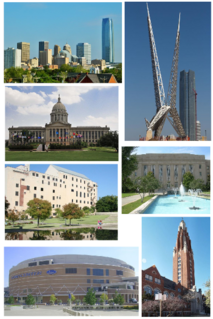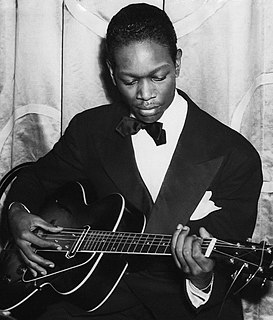
Oklahoma City, officially the City of Oklahoma City, and often shortened to OKC, is the capital and largest city of the U.S. state of Oklahoma. The county seat of Oklahoma County, it ranks 20th among United States cities in population, and is the 8th largest city in the Southern United States. The population grew following the 2010 census and reached 687,725 in the 2020 census. The Oklahoma City metropolitan area had a population of 1,396,445, and the Oklahoma City–Shawnee Combined Statistical Area had a population of 1,469,124, making it Oklahoma's largest municipality and metropolitan area by population.

William James "Count" Basie was an African-American jazz pianist, organist, bandleader, and composer. In 1935, he formed the Count Basie Orchestra, and in 1936 took them to Chicago for a long engagement and their first recording. He led the group for almost 50 years, creating innovations like the use of two "split" tenor saxophones, emphasizing the rhythm section, riffing with a big band, using arrangers to broaden their sound, and others. Many musicians came to prominence under his direction, including the tenor saxophonists Lester Young and Herschel Evans, the guitarist Freddie Green, trumpeters Buck Clayton and Harry "Sweets" Edison, plunger trombonist Al Grey, and singers Jimmy Rushing, Helen Humes, Thelma Carpenter, and Joe Williams.

Okmulgee is a city in, and the county seat of, Okmulgee County, Oklahoma. The name is from the Mvskoke word okimulgee, which means "boiling waters". The site was chosen because of the nearby rivers and springs. Okmulgee is 38 miles south of Tulsa and 13 miles north of Henryetta via US-75. Okmulgee is part of the Tulsa Metropolitan Area.

Charles Henry Christian was an American swing and jazz guitarist.

James Andrew Rushing was an American singer and pianist from Oklahoma City, Oklahoma, U.S., best known as the featured vocalist of Count Basie's Orchestra from 1935 to 1948.

Bricktown is an entertainment district just east of downtown Oklahoma City, Oklahoma, United States. It was formerly a major warehouse district. The major attractions of the district are the Chickasaw Bricktown Ballpark, the navigable Bricktown Canal, and the 16-screen Harkins movie theatre.
The Oklahoman is the largest daily newspaper in Oklahoma, United States, and is the only regional daily that covers the Greater Oklahoma City area. The Alliance for Audited Media lists it as the 59th largest U.S. newspaper in circulation.

The Paseo Arts District, originally referred to as the Spanish Village, was built in 1929 as the first commercial shopping district north of Downtown Oklahoma City by Oklahoman G.A. Nichols.
The Oklahoma City Blue Devils was the premier American Southwest territory jazz band in the 1920s. Originally called Billy King's Road Show, it disbanded in Oklahoma City in 1925 where Walter Page renamed it. The name Blue Devils came from the name of a gang of fence cutters operating during the early days of the American West.
The City of Oklahoma City uses Special Zoning Districts as a tool to maintain the character of many neighborhood communities.

The Gaslight Theatre is a nonprofit theatre troupe and venue in Enid, Oklahoma. Founded in 1966 as the Enid Community Theatre, the group stages productions of ten plays per year, including Shakespeare in the Park, musicals, and dinner theatre. Since 1989 Gaslight has called the historic Billings Theatre its home. It is located in the Enid Downtown Historic District.

Culture in North Omaha, Nebraska, the north end of Omaha, is defined by socioeconomic, racial, ethnic and political diversity among its residents. The neighborhood's culture is largely influenced by its predominantly African American community.

Downtown Oklahoma City is located at the geographic center of the Oklahoma City metropolitan area and contains the principal, central business district of the region. The CBD has over 51,000 workers and over 12,000,000 sq ft (1,100,000 m2) of leasable office space to-date. Downtown Oklahoma City is the legal, financial, economic, nightlife, and entertainment center of the region.
Downtown Tulsa is an area of approximately 1.4 square miles (3.6 km2) surrounded by an inner-dispersal loop created by Interstate 244, US 64, and US 75. The area serves as Tulsa's financial and business district, and is the focus of a large initiative to draw tourism, which includes plans to capitalize on the area's historic architecture. Much of Tulsa's convention space is located in downtown, such as the Tulsa Performing Arts Center and the Tulsa Convention Center, and the BOK Center. Prominent downtown sub-districts include the Blue Dome District, the Tulsa Arts District, and the Greenwood Historical District, which includes the site of ONEOK Field, a baseball stadium for the Tulsa Drillers opened in 2010.

The Lincoln Theatre is a 582-seat performing arts venue located at 769 E. Long Street in the King-Lincoln Bronzeville neighborhood of Columbus, Ohio. The theater is owned by the City of Columbus under the auspices of the Lincoln Theatre Association. Operation of the facility is managed by CAPA. It was listed on the National Register of Historic Places in 1992.
Metropolitan Area Projects Plan (MAPS) is a multi-year, municipal capital improvement program, consisting of a number of projects, originally conceived in the 1990s in Oklahoma City by its then mayor Ron Norick. A MAPS program features several interrelated and defined capital projects, funded by a temporary sales tax, administered by a separate dedicated city staff funded by the sales tax, and supervised by a volunteer citizens oversight committee.

The Poncan Theatre is a historic theater in Ponca City, Oklahoma. It is individually listed on the National Register of Historic Places, and is a contributing property of the Downtown Ponca City Historic District.

Zelia N. Breaux was an American music instructor and musician who played the trumpet, violin and piano. She organized the first music department at Langston University in Oklahoma and the school's first orchestra. As the Supervisor of Music for the segregated African American schools in Oklahoma City, Breaux organized bands, choral groups and orchestras, establishing a music teacher in each school in the district. She had a wide influence on many musicians including Charlie Christian and Jimmy Rushing, as well as novelist Ralph Ellison. Breaux was the first woman president of the Oklahoma Association of Negro Teachers and was posthumously inducted into the Oklahoma YWCA Hall of Fame, Oklahoma Women's Hall of Fame and the Oklahoma Bandmasters Association Hall of Fame. The Oklahoma City/County Historical Society made a posthumous presentation of its Pathmaker Award to Breaux in 2017.

The Loew's Valencia Theatre is a former movie palace at 165-11 Jamaica Avenue in Queens, New York City. Built in 1929 as one of the Loew's Wonder Theatres, the theater was donated to The Tabernacle of Prayer for All People in 1977. It was designated an exterior landmark on May 25, 1999 by the New York City Landmarks Preservation Commission.
The W. H. Slaughter House is the historic home of prominent Oklahoma City doctor, developer, and architect Wyatt Hardy Slaughter. It is listed on the National Register of Historic Places.














